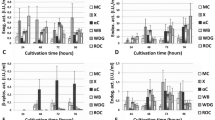Abstract
An anaerobic fungal isolate, CR4, was isolated from the bovine rumen. The DNA sequence of internal transcribed spacer region 1 showed that CR4 belonged to the genus Caecocmyces. The dry matter digestibility of timothy hay by anaerobic fungal isolate CR4 was determined. The effects of carbohydrate growth substrates on carboxymethyl cellulase (CMCase) and xylanase activities also were examined. The extent of dry matter digestibility of timothy hay was 31% at 6 days’ incubation. The highest specific activity of CMCase in the culture supernatant (SN) fraction was observed in xylose culture. The activity of CMCase was not detected in the SN fraction of cellobiose and xylan or in the cell-bound fraction of all growth substrates. The highest specific activity of xylanase in the SN fraction was observed in glucose culture. These results suggest that fiber-degrading enzyme activities were affected by growth substrates and that CR4 is xylanolytic. Zymogram analysis showed that CR4 produces three CMCases of molecular mass (95, 89, and 64 kDa) and three xylanases of molecular mass (82, 73, and 66 kDa). This is the first demonstration showing the molecular mass of fiber-degrading enzymes of Caecomyces.


Similar content being viewed by others
References
Brookman JL, Mennim G, Trinci APJ et al (2000) Identification and characterization of anaerobic gut fungi using molecular methodologies based on ribosomal ITS1 and 18S rRNA. Microbiol 146:393–403
Dijkerman R, Op Den Camp HJM, van der Drift C (1996) Cultivation of anaerobic fungi in a 10-l fermenter system for the production of (hemi-) cellulolytic enzymes. Appl Microbiol Biotechnol 46:85–91
Durand R, Rascle C, Fèvre M (1996) Molecular characterization of xyn3, a member of the endoxylanase multigene family of the rumen anaerobic fungus Neocallimastix frontalis. Curr Genet 30:531–540
Gordon GLR, Phillips MW (1993) Removal of anaerobic fungi from the rumen of sheep by chemical treatment and the effect on feed consumption and in vivo fibre digestion. Lett Appl Microbiol 17:220–223
Hodrová B, Kopečný J, Káš J (1998) Cellulolytic enzymes of rumen anaerobic fungi Orpinomyces joyonii and Caecomyces communis. Res Microbiol 149:417–427
Joblin KN (1981) Isolation, enumeration, and maintenance of rumen anaerobic fungi in roll tubes. Appl Environ Microbiol 42:1119–1122
Joblin KN, Matsui H, Naylor GE et al (2002) Degradation of fresh ryegrass by methanogenic co-cultures of ruminal fungi grown in the presence and absence of Fibrobacter succinogenes. Curr Microbiol 45:46–53
Matsui H, Ushida K, Miyazaki K et al (1998) Use of ratio of digested xylan to digested cellulose (X/C) as an index of fiber digestion in plant cell-wall material by ruminal microorganisms. Anim Feed Sci Technol 71:207–215
Matsui H, Ogata K, Tajima K et al (2000) Phenotypic characterization of polysaccharidases produced by four Prevotella type strains. Curr Microbiol 41:45–49
Orpin CG (1976) Studies on the rumen flagellate Sphaeromonas communis. J Gen Microbiol 94:270–280
Orpin CG (1994) Anaerobic fungi: taxonomy, biology, and distribution in nature. In: Mountfort DO, Orpin CG (eds) Anaerobic fungi: biology, ecology, and function. Marcel Dekker, Inc., New York, NY, pp 1–45
Ozkose E, Thomas BJ, Davies DR et al (2001) Cyllamyces aberensis gen.nov. sp.nov, a new anaerobic gut fungus with branched sporangiophores isolated from cattle. Can J Bot 79:666–673
Roger V, Grenet E, Jamot J et al (1992) Degradation of maize stem by two rumen fungal species, Piromyces communis and Caecomyces communis, in pure cultures or in association with cellulolytic bacteria. Reprod Nutr Dev 32:131–136
Saitou N, Nei M (1987) The neighbor-joining method: a new method for reconstructing phylogenetic trees. Mol Biol Evol 4:406–425
Williams AG, Orpin CG (1987) Polysaccharide-degrading enzymes formed by three species of anaerobic rumen fungi grown on a range of carbohydrate substrates. Can J Microbiol 33:418–426
Williams AG, Orpin CG (1987) Glycoside hydrolase enzymes present in the zoospore and vegetative growth stages of the rumen fungi Neocallimastix patriciarum, Piromonas communis, and an unidentified isolate, grown on a range of carbohydrates. Can J Microbiol 33:427–434
Wood TM, Wilson CA, McCrae SI et al (1986) A highly active extracellular cellulase from the anaerobic rumen fungus Neocallimastix frontalis. FEMS Microbiol Lett 34:37–40
Acknowledgments
The authors would like to thank Dr. Yasunari Yamamoto (Livestock Research Division, Mie Prefectural Science and Technology Promotion Center) for providing rumen fluid. This study was supported by the Integrated Research for Developing Japanese-style Forage Feeding System to Increase Forage Self-Support Ratio of the Ministry of Agriculture, Forestry and Fisheries of Japan. The authors would also thank to Ms. Ayaka Fukuda (Mie University) for her assistance in cultivation and measurements. Nucleotide sequence analysis was done at the Life Science Research Center, Center for Molecular Biology, and Genetics of Mie University.
Author information
Authors and Affiliations
Corresponding author
Rights and permissions
About this article
Cite this article
Matsui, H., Ban-Tokuda, T. Studies on Carboxymethyl Cellulase and Xylanase Activities of Anaerobic Fungal Isolate CR4 from the Bovine Rumen. Curr Microbiol 57, 615–619 (2008). https://doi.org/10.1007/s00284-008-9252-3
Received:
Revised:
Accepted:
Published:
Issue Date:
DOI: https://doi.org/10.1007/s00284-008-9252-3




